By Lorna Bointon, Sea Watch Foundation Regional Coordinator

A serene sea in the golden glow of a setting sun. Image by R Bointon
Research has shown that being by the seaside can benefit our emotional, physical and mental wellbeing. Who doesn’t feel better after a coastal walk in bracing sea air, tasting salty spray on our lips and hearing seabirds crying and wheeling overhead?
For this reason, I would like you to take a deep breath and join me on a virtual seaside stroll to stimulate your senses. To set the scene, imagine walking along a coastal path serenaded by the sounds of gulls as they soar noisily overhead.
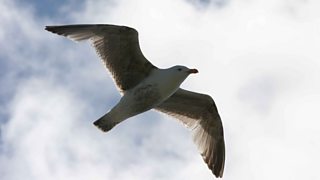
A herring gull is a familiar seaside sight. Image PGH Evans

Burnet roses (Rosa spinosissima) growing along a coastal path. Image R Bointon
Sun, sea and salty air
As we hear and feel the crunch of sand beneath our feet, feel the sun on our face, the breeze in our hair and smell the familiar seaside tang in our nostrils, we fill our bodies with feel-good hormones called endorphins.
Did you know that the familiar sulphurous smell of the sea emanates from dimethyl sulphides (DMS) released by marine algae and phytoplankton and that it plays a role in cloud formation? There is always something to see, hear, sense or learn about the ever changing sea.
On coastal paths we may also encounter the bright yellow blooms of gorse with their familiar coconut scent.
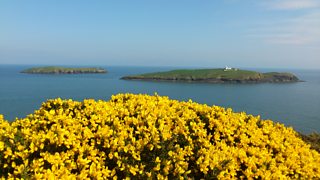
The heat of the sun brings out the coconut scent of gorse. Image R Bointon
A walk on the wild side
As you join me in a virtual stroll along a favoured beach or cliff path, imagine the waves lapping against the shore with mesmeric repetition or rolling in, crashing onto the sand with a swish and then drawing back with a clatter of pebbles, leaving behind frothy bubbles in its wake.
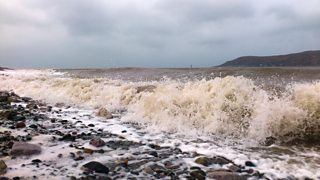
Frothy waves crashing onto the shore. Image R Bointon
The constant process of incoming and outgoing tides is controlled by the sun and moon exerting a gravitational force.
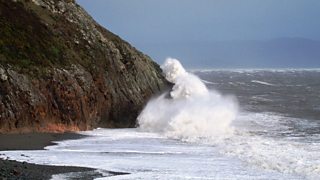
The tides are influenced by both the moon and the sun. Image R Bointon
The sea can change in an instant from tranquil calm with sunbeams dancing across a glassy surface to rolling and heaving angrily, dashing against rocks and exploding onto the shore.
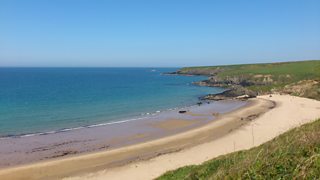
A calm sea with blue skies. Image R Bointon
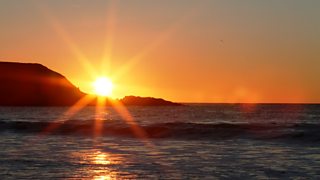
A tranquil sunset. Image R Bointon

A stormy sea. Image R Bointon

The mood of the sea can change very quickly. Image R Bointon
Regeneration and rebirth
As we walk, imagine ribbons of shiny seaweed intertwined in a slippery embrace and delicate papery balls of whelk egg cases left behind by the ebbing tide. As starfish and jellyfish are helplessly brought ashore by the unforgiving tide, discarded mermaids purses (skate, dogfish and ray egg cases) help to remind us of new-born marine life.
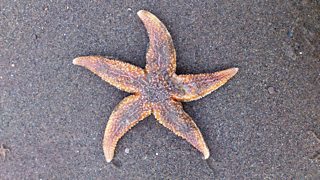
Starfish, also known as sea stars, have regenerative abilities. Image R Bointon
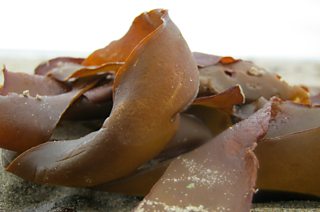
Ribbons of intertwined seaweed. Image L Bointon
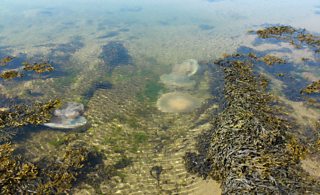
Jellyfish and seaweed. Image R Bointon
Exploring rock pools can take us back to our childhood, a time when we excitedly made discoveries and gazed in wonderment as tiny crabs sidled along the bottom or jewel bright anemones peeked out from the seaweed covered rocks.
Flower Power
Seaside specialist plants are a delight to encounter on a coastal walk not just for their attractive forms, colours and scents but also for their sustaining presence, providing food and shelter for many organisms. Halophytes are salt tolerant plants able to withstand a saline environment.
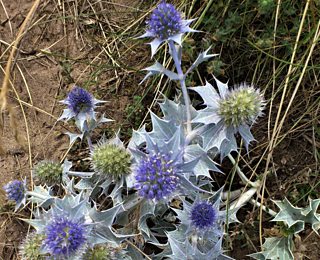
Sea holly (Eryngium maritimum) Image R Bointon
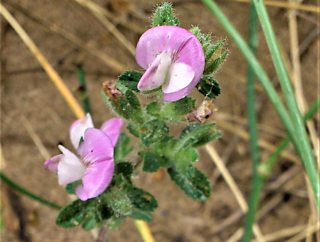
Common restharrow (Ononis repens) Image R Bointon
The name halophyte is derived from ‘halas’ meaning salt and ‘phyte’ meaning plant. Botany plays its part in the complex marine environment from beautiful swathes of thrift covering sea sprayed cliffs down to tall marram grasses and other halophytes helping to stabilise dunes and saltmarshes against erosion. Botany doesn’t stop at the shoreline but extends beyond into the ocean itself in the form of seagrass meadows.
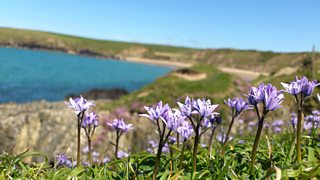
Sea squill Scilla verna. Image R Bointon
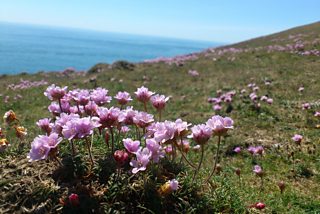
Sea thrift, Armeria maritima. Image R Bointon
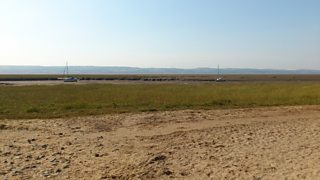
Saltmarsh plants help to stabilise and protect against erosion. Image R Bointon
Seagrasses are true plants, photosynthesising and reproducing in the same way as terrestrial plants. Through their ability to photosynthesise and generate oxygen, seagrass meadows are known as the ‘lungs of the sea’. They also help to support and provide shelter for marine organisms, including sea horses.
Every breath we take
Being air breathing mammals, cetaceans (porpoises, dolphins and whales) rely on the oxygenating service provided by seagrasses and other photosynthesising organisms. Imagine a magical moment when a dorsal fin breaks the surface and a dolphin emerges from the depth with a soft exhalation before dropping back beneath the waves. These cetaceans are visible indicators of ocean health and their presence or absence can help to alert us to changes in our marine environment. When you next think of the sea, take a deep breath and give thanks to the plants that help provide an essential life service, not just to us but also to the cetaceans that inhabit our oceans.

Breaching bottlenose dolphin. Image R Bointon
That’s why, with every breath we take, we’ll be watching the seas and we hope that you too will soon be able to join us in celebrating this very special environment.
Could experiencing nature virtually help us beat the lockdown blues?
A groundbreaking new study from the scientists behind Forest 404 explores how virtual experiences of nature might impact wellbeing - and .
